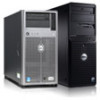Dell PowerEdge 4100 Service Manual - Page 3
System Overview - 200 scsi
 |
View all Dell PowerEdge 4100 manuals
Add to My Manuals
Save this manual to your list of manuals |
Page 3 highlights
Chapter 1 System Overview The Dell® PowerEdge® 4100 systems covered in this manual are high-speed, upgradable server systems, which use the Intel® Pentium® Pro family of microprocessors. PowerEdge 4100 systems incorporate the high-performance peripheral component interconnect (PCI) local bus as well as the extended industry-standard architecture (EISA) expansion bus. These buses are built into the system board, which integrates the microprocessor(s) and other elements of the basic computer system. PowerEdge 4100 systems may have one or two Pentium Pro microprocessors. The systems have been designed for better serviceability and increased reliability, with optional redundant power supplies, RAID capability, hot-pluggable SCSI hard-disk drives, thermal and power supply monitoring, redundant fans, and ECC memory. The PowerEdge 4100 systems are freestanding or can be rackmounted to integrate your servers. The microprocessor modules are installed in zero insertion force (ZIF) sockets on the system board, which allow you to replace microprocessors faster. Contact Dell for information about Dellsupported microprocessor upgrades. The Pentium Pro microprocessor contains a built-in clock multiplier circuit, which increases the microprocessor's internal operating frequency to a multiple of the system clock frequency. The microprocessors for each of these systems and their operating frequencies are as follows: • Dell PowerEdge 4100/180 system - 180 MHz derived from a system clock frequency of 60 MHz • Dell PowerEdge 4100/200 system - 200 MHz derived from a system clock frequency of 66 MHz System Features In addition to the standard features found in a traditional personal computer, Dell PowerEdge 4100 systems include the following new and/or advanced features: • 256 KB (PowerEdge 4100/180 systems) or 512 KB (PowerEdge 4100/200 systems) of cache memory internal to the Pentium Pro module • 64 MB of 72-bit wide, buffered, extended data output (EDO) main memory, upgradable to 1024 MB (1 GB) • Hot-pluggable SCSI backplane supporting up to six hard-disk drives • Optional, redundant hot-pluggable power supplies System Overview 1-1












